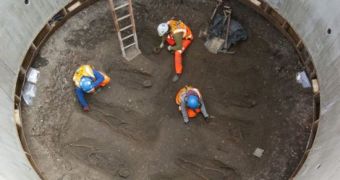Shortly after the remains of a medieval knight were unearthed in Edinburgh while demolishing a car park, the news broke that another team of workers had recently made an equally interesting find.
Long story short, the remains of 12 victims of the medieval plague were found while working on a Crossrail project in London's Charterhouse Square.
Information shared with the public says that the remains of these 12 people most likely date back to the 14th century, and that their being found all in the same location suggests that they might be part and parcel of a mass burial ground.
The researchers now busy inspecting these remains hope that, with the help of DNA tests carried out on these 12 individuals, they will be able to figure out what exactly caused the medieval plague and why it was that so many people (i.e. approximately 1.5 million) died because of it.
Daily Mail quotes lead archaeologist Jay Carver, who stated that, “This is a highly significant discovery and at the moment we are left with many questions that we hope to answer.”
For the time being, the scientists in charge of making head and tail of this archaeological find are yet to be completely sure that these 12 people are in fact victims of the so-called Black Death.
However, it appears that all of the evidence they have managed to collect thus far hints towards this theory.
“We will be undertaking scientific tests on the skeletons to establish their cause of death, whether they were plague victims from the 14th century or later residents, how old they were and perhaps evidence of who they were.”
“However, at this early stage all points towards this being part of the 14th-century emergency burial ground,” Jay Carver told members of the press.
The 12 alleged victims of the medieval plague were found at a depth of roughly 8 feet (about 2.5 meters).
Apparently, the bodies, whose hands were folded across their torso, were arranged side by side in uniform rows.

 14 DAY TRIAL //
14 DAY TRIAL //